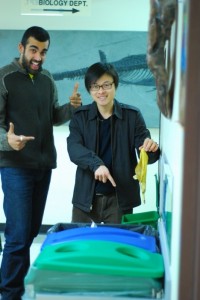On January 9, students at Lansdowne campus were welcomed back with the gift of an expanded compost program. While the rest of us were sleeping off the winter-break binge, Camosun students, faculty and physical-resources staff were hard at work getting new composters installed at the school’s waste-management stations.
The little green boxes may seem insignificant, but they’re a triumph to those involved with the compost program.
“It’s like a dream come true,” says Camosun College Student Society sustainability director Richard Kao, who has been working to get the program off the ground since 2010. “After two years, it’s done. It’s a relief.”

Environmental technology chair Anna Colangeli says Camosun’s compost program is important because of the oncoming CRD ban of organics in the landfill. The program has met this challenge by centralizing the system. Organic waste in the compost bins gets diverted to a dozen anaerobic digesters scattered around campus.
“All that waste is not going to the landfill, it’s decomposing here on campus,” says Colangeli.
Now that the boxes are installed around campus, the trick is getting students to use the composters frequently and effectively.
“I, for sure, will use the compost,” says first-year visual arts student Brianna Quinsey.
But others don’t share the same enthusiasm. Some students say they aren’t clear on exactly how the system works.
“I noticed it yesterday and I wanted to know what I was supposed to do with my banana peel,” says university transfer student John Little. “There’s no information. No pictures or words on the front of it.”
Colangeli says that answering these concerns is the current priority.
“The next phase is going to be the education component,” she says. “Making sure that everybody buys into this, so that nobody puts any compostable matter into the garbage. The beauty of the anaerobic digesters is that any organics can go in. Cooked food, greasy food, dairy products, bonesŃit can all go in there.”
The compost program makes for an eco-friendly campus, and it also contributes to the student job market. Samuel Jan is one of two students who have been hired to collect the green bin waste, which, due to the sometimes unpleasant nature of organics, is a daily routine. Jan says that the program has seen some success.
“We’re still working out the kinks,” says Jan, “but I think it’s been pretty successful. It’s a concept that not every student has regularly practiced or is aware of. But it’s a great kick-start.”
Colangeli is also impressed by the response to the program.
“It’s so successful here, our plan is to get something like this at Interurban,” she says. “After so many false starts over the years, we’ve finally got something off the ground that looks sustainable.”

